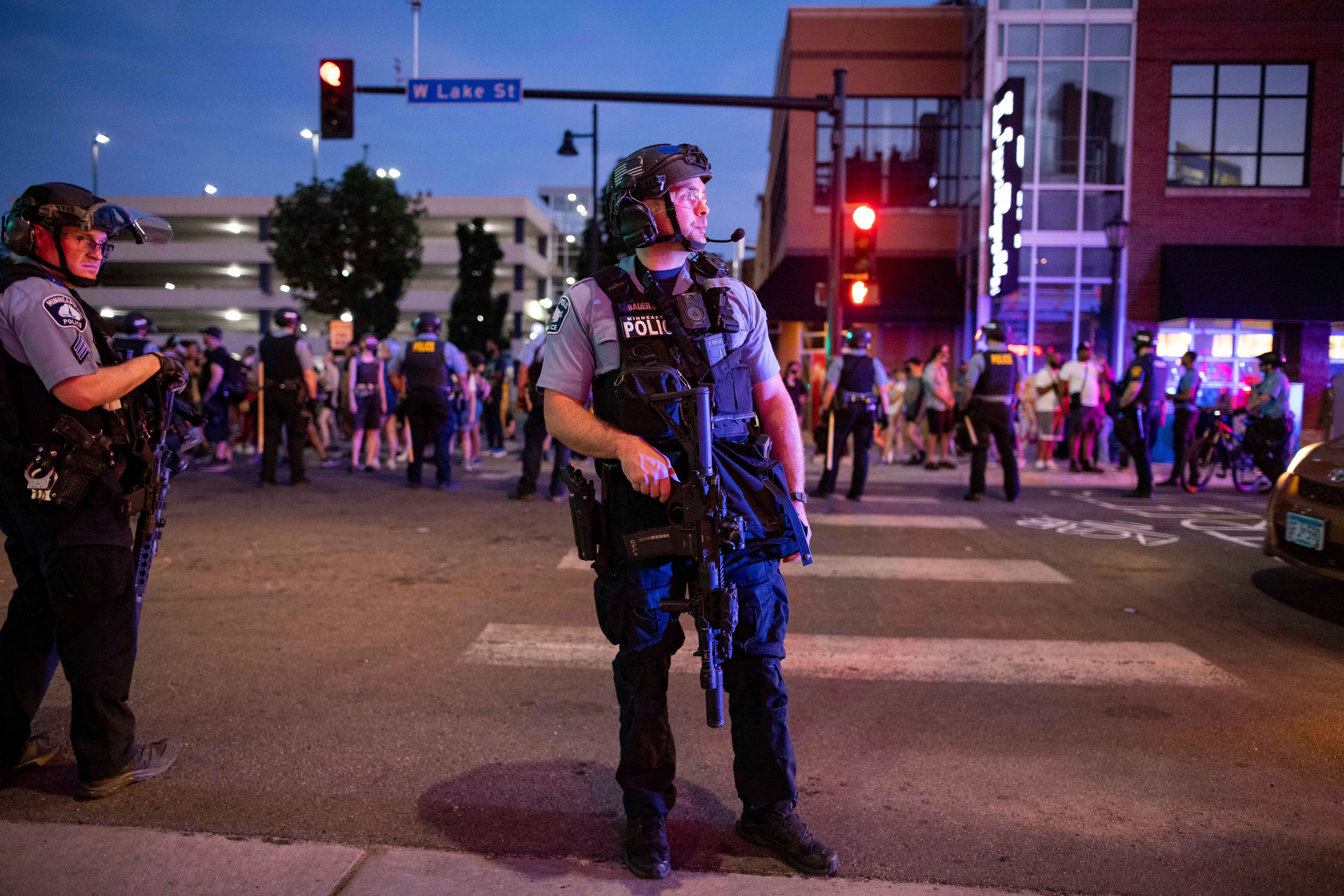Police with assault rifles and silencers clear out memorial to slain Black man in Minneapolis
Demonstrators have been holding vigils and protests in the space since Winston Smith, a Black man, was killed by local deputies on a fugitive taskforce earlier this month

Your support helps us to tell the story
From reproductive rights to climate change to Big Tech, The Independent is on the ground when the story is developing. Whether it's investigating the financials of Elon Musk's pro-Trump PAC or producing our latest documentary, 'The A Word', which shines a light on the American women fighting for reproductive rights, we know how important it is to parse out the facts from the messaging.
At such a critical moment in US history, we need reporters on the ground. Your donation allows us to keep sending journalists to speak to both sides of the story.
The Independent is trusted by Americans across the entire political spectrum. And unlike many other quality news outlets, we choose not to lock Americans out of our reporting and analysis with paywalls. We believe quality journalism should be available to everyone, paid for by those who can afford it.
Your support makes all the difference.Trauma and déjà vu are setting in for demonstrators in Minneapolis, where police violence against Black men inspires protests, and those protests are often met with violent policing.
On Tuesday night, demonstrators reported that Minneapolis policeman Mark Ringgenberg — one of the officers who shot and killed a Black man named Jamar Clark in 2015 in unclear circumstances, which inspired weeks of protests — was among a phalanx of heavily armed police officers with silenced assault rifles who helped clear out a memorial honouring both Winston Smith, a Black man killed by local deputies in similarly unclear circumstances earlier this month, and Deona Marie Erickson, a demonstrator at the protests that followed who was rammed to death by a rogue driver at the scene on Sunday.
“Maybe George Floyd wasn’t the final straw for Minneapolis. Which is wild to think about. But this city feels like it’s reaching another breaking point,” wrote Minneapolis-based activist and documentary photographer Patience Zalanga on Twitter that night, adding, “It’s realty hitting me that they had the audacity to have Jamar Clark’s killers out here in the streets ambushing protesters in Uptown. Wow. How low can we go, I see.”
Protesters have been demonstrating and occupying a stretch of Minneapolis’ busy Lake Street since early June, after two local sheriff’s deputies serving on a federal fugitive taskforce shot and killed Mr Smith, Jr, 32, on 3 June.
The two deputies who killed him were both wearing body cameras, but had been instructed not to turn them on, even though in October the Justice Department reversed a longstanding policy preventing officers on federal fugitive task forces from wearing them.
The Minnesota state Bureau of Criminal Justice has said it will not release the names of the officers because they were working undercover.
Police say they were attempting to serve an arrest warrant on Mr Smith, who had missed a sentencing hearing where he was set to serve a four-year prison term, when he “produced a handgun” and a shootout ensued. A woman who was with Mr Smith said she never saw him with a gun inside the car at all. (A search of the scene uncovered a handgun, pistol magazines, and spent ammunition casings).
Following Mr Smith’s then Ms Erickson’s deaths, the space has become another zone for protest and vigil, a smaller-scale version of the way the site of George Floyd’s murder in Minneapolis became an ongoing community gathering spot for more than a year since his death last May.
And just as local officials have attempted to dismantle many of the installations at the now-iconic George Floyd Square, on Tuesday the city made good on its promise to take down barricades on Lake Street.
Armed riot police and city public works crews arrived at the scene twice on Tuesday, first in the afternoon and later at night, and hauled off barricades in trucks as officers ordered crowds to disperse.
Crews also began taking down a garden and other memorials at the site.
Protesters and journalists reported not being able to hear any dispersal orders before a crowd of officers descended on the crowd that evening, making arrests. (Earlier on Tuesday, the mayor had promised to warn protestors and give them time to leave the area before any police moved in on the crowd.)
Officers, who claimed they were hit by thrown debris, fired less lethal crowd control weapons and pepper spray into the crowd, as others armed with assault rifles or long clubs ordered the demonstrators to leave.
"We can’t have a major commercial corridor like this shut down; we can’t have unauthorised closures of our streets, period," Minneapolis Mayor Jacob Frey said on Tuesday afternoon at a press conference. "We’ve been prioritising de-escalation all along, yet the atmosphere of the area has substantially shifted."
Some community residents and business owners have also complained that the demonstrations have impacted the area.
“It’s gotten pretty aggressive for the business owners, aggressive for the residents, aggressive for the visitors,” Tim McHugh, owner of the Amore Upton restaurant, told CBS Minnesota. “Many, many, many people, starting last weekend, simply cancelled over concerns over safety in Uptown, and that’s having an impact on all the local businesses, not just ours.”
The tragedy added a new layer to a city that’s already been deeply traumatised after back-to-back-to-back killings of Black men by police in recent months, including George Floyd, Daunte Wright, and now Winston Smith.
Join our commenting forum
Join thought-provoking conversations, follow other Independent readers and see their replies
Comments